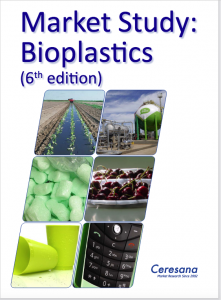
Compostable disposable tableware, mulch films that rot on the field, or fishing nets that simply disintegrate over time: are bioplastics the solution to waste problems? High hopes are being placed in plastics made from sugar cane, potato starch or other renewable raw materials. Biopolymers are conquering an increasing number of application areas and achieve significantly higher growth rates than conventional standard plastics. Ceresana has analyzed the dynamically growing global market for “green” polymers for the sixth time: Analysts expect revenues from bioplastics to rise to approx. USD 8.1 billion by 2030.
Biobased and Biodegradable Plastics
In this study, two groups of materials are considered to be “bioplastics”. These two groups can overlap but don’t have to be identical:
- biodegradable plastics, which decompose in the wild or can at least be composted in industrial facilities,
- biobased plastics, which are produced from renewable raw materials.
Some bioplastics meet both conditions: for instance, PLA made from polylactic acid, PHA from sugar and TPS from starch are biobased and biodegradable. However, there are also plastic made from biogenic raw materials that are not compostable (e.g. PEF from fructose or bio-PE based on sugar cane). In contrast, some petrochemical plastics, i.e. plastics produced from crude oil or natural gas, may well be biodegradable (e.g. PCL, PBAT, PBS). As long as biobased plastics have the same chemical structure as their fossil counterparts, they can be recycled.
Fossil-based fiber-reinforced plastics, elastomers, thermosets, and wood-plastic composites (WPC) are not considered in this study.
Key Role for the EU Circular Economy
Plastics and packaging are central product groups for the “Circular Economy Action Plan” published by the EU Commission in spring 2020 as part of the “Green Deal”. In order to overcome the throwaway society and reduce the amount of waste, the EU Commission has plans for, among other things, a plastic tax, restrictions on microplastics and the promotion of plastic recycling. By the end of 2021, a new “framework legislation for bio-based, biodegradable and compostable plastics” should clearly regulate and define what is meant by these terms and how bioplastics should be disposed of. Greenwashing is to be avoided by means of a life cycle analysis: Biobased plastics should only be used if they offer real ecological advantages over fossil plastics and should not compete with food production, for example.
Greatest Growth in Polylactic Acids and Starch
Biodegradable plastics, for example polylactic acids (PLA) and starch polymers, reached a market share of 65% of the total bioplastics market in 2020. For this product group, Ceresana expects further growth of 10.2% per year until 2030. For biobased plastics, such as polyethylene, PET or PA, which are not biodegradable, growth is expected to be lower with 7.5% per year. Ceresana’s latest market report analyzes how the use of bioplastics is developing in different sales markets. The most important sales market for bioplastics in 2020 was the packaging industry – more than 58% of all bioplastics were processed here. Ceresana expects the highest growth in the market for bags and sacks with 11.1% per year.
The Study in Brief:
Chapter 1 of the study provides a comprehensive presentation and analysis of the global bioplastics market – including forecasts up to 2030: for each region, the development of demand (tonnes), sales (USD and EUR) and production (tonnes) is presented. In addition, the application areas of bioplastics are examined individually: rigid packaging, flexible packaging (bags, sacks, pouches and other packaging), consumer goods, automotive and electronics, other applications.
For the regions Europe, North America, Asia-Pacific and “Rest of the World”, the production of bioplastics is divided into the product groups: PLA, starch, other biodegradable and non-biodegradable plastics. The demand for bioplastics per region is broken down into:
- Polylactic acid (PLA)
- Starch
- Polyhydroxyalkanoates (PHA)
- Polybutylene adipate terephthalate (PBAT)
- Other biodegradable plastics
- Bio-polyethylene (PE)
- Other non-biodegradable plastics
In Chapter 2, the 8 most important sales countries are considered individually: Germany, France, the United Kingdom, Italy, Spain, the USA, China and Japan. The following categories are shown in each case: Demand and revenues, demand for the individual application areas and demand by product type (PLA, starch-based, other biodegradable plastics, non-biodegradable biobased plastics).
Chapter 3 provides useful company profiles covering the most important bioplastics manufacturers, clearly arranged by contact details, revenues, profit, product range, production sites and brief profile. Detailed profiles are provided by 91 manufacturers, e.g. BASF SE, Braskem S.A., Far Eastern New Century Corporation (FENC), NatureWorks LLC, Novamont S.p.A., Rodenburg Biopolymers B.V., Solvay SA, Teijin Limited, and Vegeplast S.A.S.
Source
Ceresana Research, press release, 2021-09-01.
Supplier
BASF SE
Far Eastern New Century Corporation (FENC)
NatureWorks LLC
Novamont S.p.A.
Rodenburg Biopolymers B.V.
Solvay
Teijin Ltd.
Vegeplast S.A.S.
Share
Renewable Carbon News – Daily Newsletter
Subscribe to our daily email newsletter – the world's leading newsletter on renewable materials and chemicals









